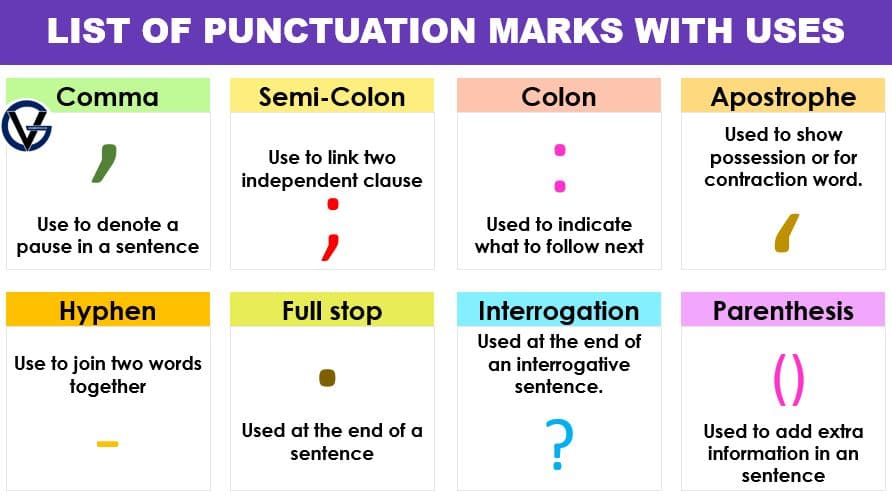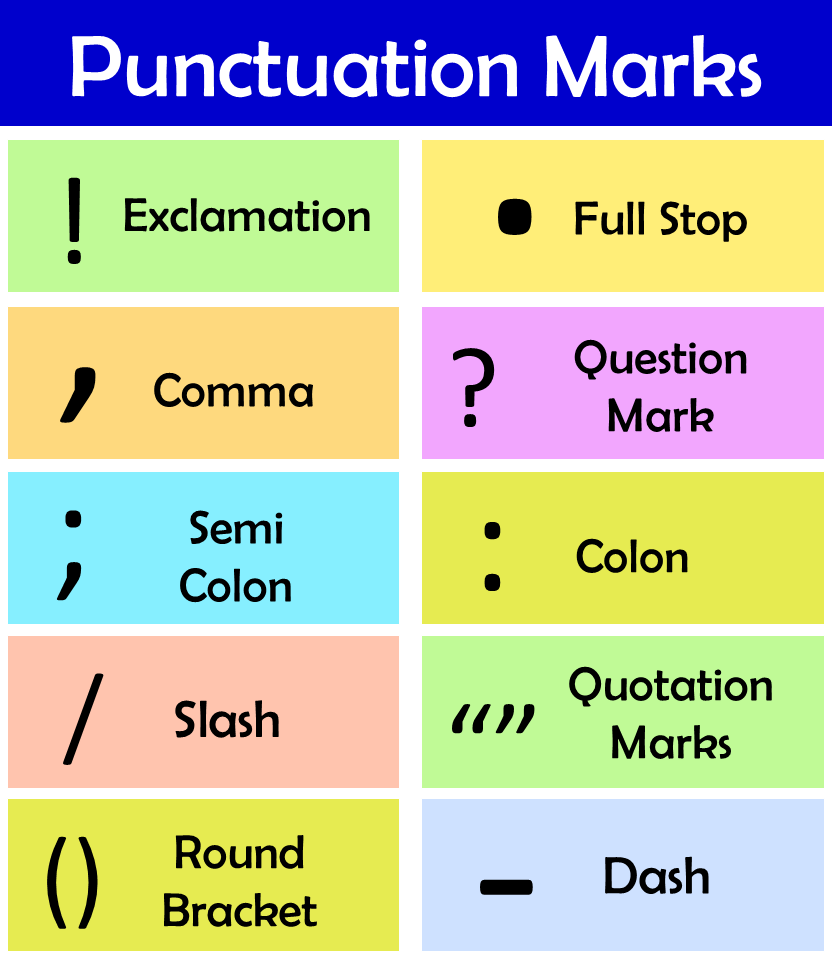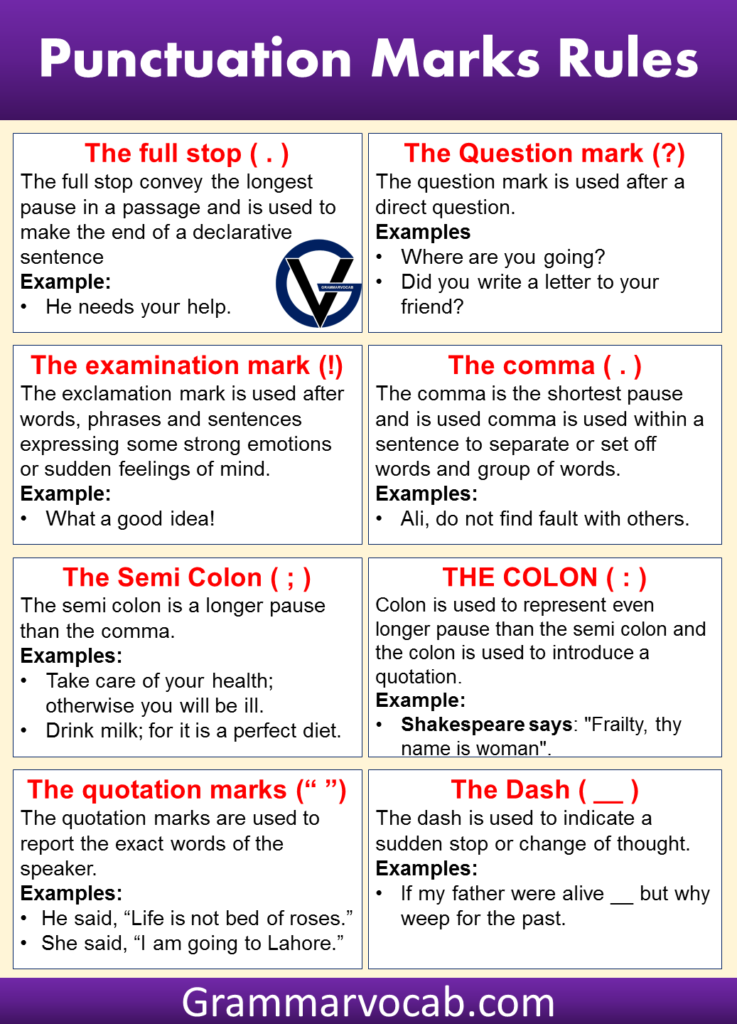Punctuation marks are the traffic signals of language: they tell us to slow down, notice this, take a detour, or stop. They are essential tools in writing, helping to clarify the meanings of texts and convey the writer’s intent. In this article, we’ll explore the most common punctuation marks with examples in English, providing clear examples of each to help readers understand their usage. Whether you’re a student, a professional writer, or someone looking to polish your writing skills, this guide will prove invaluable.
What is a Punctuation?
Punctuation refers to the symbols used in writing to clarify meaning and indicate pauses, sentence boundaries, and the structure of sentences. These symbols help organize text into manageable units, making it easier to read and understand. Common punctuation marks include:
- Period (.): Marks the end of a declarative sentence.
- Comma (,): Indicates a pause or separates items in a list.
- Question Mark (?): Ends a question.
- Exclamation Mark (!): Shows excitement or emphasis.
- Colon (:): Introduces a list, quote, or explanation.
- Semicolon (;): Links closely related independent clauses or separates items in a complex list.
- Apostrophe (’): Shows possession or forms contractions.
- Quotation Marks (“ ”): Enclose direct speech, quotations, or titles.
- Hyphen (-): Joins words in a compound term or splits a word at a line break.
- Dash (–): Indicates a range or pause, or adds emphasis.
- Parentheses (()): Enclose additional information or asides.
- Brackets [ ]: Indicate editorial comments or clarifications within quoted text.
- Ellipsis (…): Indicates an omission or pause.

List of Punctuation Mark Explained
Punctuation marks are symbols that are used to aid the clarity and comprehension of written language. Some of the most common punctuation marks are:
THE FULL-STOP
The full stop is used:
- At the end of a sentence that is not interrogative or exclamatory. It separates a sentence from the following one.
- After abbreviation, M.A., PhD., viz.
THE COLON
The colon is used:
To introduce a direct statement or a direct question.
- Become says: “Reading makes a full man, writing an exact man, speaking a ready man.”
- The barrister: did you see the accused stab the deceased?
- The witness: No, sir.
To introduce a list, or enumerate details.
- It cost you nothing: it cost me a lie
- Shakespeare’s four greatest tragedies are; Hamlet, Macbeth.
Between two sentences so closely connected in thought that the second can be regarded as an illustration, an expression, repetition, or simplification of the first sentence.
- This man is a habitual criminal: he has been four times convicted of felony and is still leading a dishonest life.
THE SEMI-COLON
The semi-colon is used:
To separate long co-ordination clauses when the connection is absent.
- The appreciator of an aesthetic achievement becomes in his minor way an article; he cannot rest without communication what has been communicated to him.
To separate co-ordinate clauses joined by the conjunction that expresses opposition, or introduces an inference.
- They do not come within the narrow range of the law of the bible; for to misrepresent a man’s attitude and opinion is no offense.
To separate a number of parallel clauses forming a series grouped as one sentence.
- The coconut tree gives us food; it gives us drink; it gives us rafters; it gives us oil & it gives us rope; it supplies us, indeed, with nearly all necessaries of life.
THE COMMA
In a sentence containing a series of words belonging to the same part of speech:
- John bought pens, pencils, exercise books and other articles of stationery.
- The chief guest alighted from the car, shook hands with the hosts, and entered, the Auditorium.
In sentences containing two or more phrases qualifying the same word :
- All kinds of articles can now be transported by road, by sea, or by air.
Indirect speech, where the speaker is introduced in the middle of the speech ;
- “I am not interested in this conversation,” said the Manager, “unless of course, you have a specific proposal to make.”
To make off words and phrases like however, indeed, therefore, too, for instance, no doubt, in fact. Etc.
- You are, therefore, the obvious target.
- It is, indeed, a pleasure to work with you.
- I realized, no doubt, that he was, in fact, the boss
- I am not, however, convinced by your argument.
To mark off nouns, words, or phrases in apposition and absolute construction :
- Lahore, the city of colleges. Is the heart of Pakistan?
- Quaid-i-Azam, the founder of Pakistan, as the people of Pakistan call him, was one of the best speakers the sub-continent has produced.
- Having done my duty, I proceeded to Karachi.
- I am not, to tell the truth, impressed by your proposal.
To mark off a series of noun clauses or adjective clauses :
- I do not know where he went, or why he did it.
- He is a teacher who is never satisfied with what he has learned, and who is always determined to acquire more knowledge.
To separate two co-ordinate clauses :
-
- He had reached the pinnacle of glory, but he realized soon enough that it was difficult to maintain it.
After each preposition, when there is two prepositions to one object :
-
- Your care is superior to and bigger than, the one I have.
To indicate the omission of a verb :
-
- Your sister received a fountain pen; my sister, a watch.
SIGN OF INTERROGATION
The sign of interrogation/question mark is used after a sentence that asks questions.
- Have you done your duty?
- Why do you take pleasure in giving pain to another person?
EXCLAMATION MARK
The exclamation mark is used after words or sentences which express an emotion or a wish
- Hurrah! We have won the match.
- May you live long!
- O, what a fly is there, my countrymen!
DASH
The dash is used:
- To indicate an abrupt change or sudden bream in a sentence.
This was calculated to cause pain and distress to my servant_ but why should anybody care?
- To mark a parenthesis.
Any public person_ writer, speaker, actor, politician_is subtly made to feel that if he offends the press he will suffer for it.
- Before a repeated word.
You could not be oblivious of the consequences_ the consequences which can have a far reaching effect on your career.
- Before demonstrative pronoun (there, those, such) when they are used, to sum up a number of assertions previously made.
An utter lack of intelligent interest, dreary boredom, and discontent, an entire want of conscience about the getting and spending of money_ these are the only states of mind that could drive anyone to the gambling table or the sporting columns of newspapers.
INVERTED COMMA’S
The inverted commas are used to indicate the exact words of a speaker or a quotation.
He said, “May God bless you!”
NOTE: if a quotation occurs within a quotation, it is marked by single inverted commas.
He said, “We must remember that “Honesty is the best policy.”
PARENTHESIS
Parenthesis are brackets that are used to separate from the main part of a sentence a phrase or clause, which does not grammatically belong to it.
In America, says the encyclopedia libertarian (from which most of these figures are taken), there were only five sadists of importance in 1913, and now (1930) there are thirty.
HYPHEN
The Hyphen is used:
- Sister-in-law
- Brother-in-law
To divide words into syllables and between one line and the next.
- Par-a-graph
- Un-cer-tain
APOSTROPHE
The apostrophe is used:
To indicate the omission of some letter or letters from a word.
- I’ve
- can’t
To show the genitive case of the noun.
- Horse’s tail
- Hero’s acting
In the plurals of such words as the following.
- Don’t the I’s and cross the t’s.
- Mind your P’s and Q’s
NOTE: capital letters are used to indicate.
- The first word of a sentence.
- The first word of every line verse
- All proper noun and adjectives derived from them:
Lahore, America, American, Shakespeare, Shakespearean.
- Noun and pronoun relating to the Deity.
Let us thank God for his manifold mercies.
- The pronoun I, and the interjection O.
Infographics (List of Punctuation Marks)






Complete list of punctuation marks Pdf

